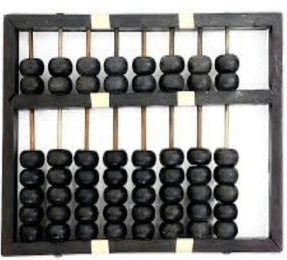History of Computers
The first counting device was used by the primitive people. They used sticks, stones and bones as counting tools. As human mind and technology improved with time more computing devices were developed. Some of the popular computing devices starting with the first to recent ones are described below;Abacus
The history of computer begins with the birth of abacus which is believed to be the first computer. It is said that Chinese invented Abacus around 4,000 years ago.It was a wooden rack which has metal rods with beads mounted on them. The beads were moved by the abacus operator according to some rules to perform arithmetic calculations. Abacus is still used in some countries like China, Russia and Japan. An image of this tool is shown below;
1. Precursors to the Computer Age (Pre-20th Century)
The origins of computing can be traced back to ancient civilizations that developed various tools and devices to aid in calculations. The abacus, invented by the Sumerians around 2000 BC, is one such early computing device. It consisted of beads on rods and allowed for basic arithmetic operations.In the 17th century, the French mathematician Blaise Pascal designed the Pascaline, a mechanical calculator capable of performing addition and subtraction. Shortly after, in the 19th century, Charles Babbage, an English mathematician, conceptualized the "Analytical Engine," a mechanical device capable of performing general-purpose computation. Although Babbage's invention was never built during his lifetime, it laid the theoretical foundation for modern computers.
2. The Emergence of Mechanical Calculators (Late 19th Century - Early 20th Century)
The late 19th and early 20th centuries saw the development of several mechanical calculators that could perform arithmetic operations. The most notable of these was the "Curta," a handheld mechanical calculator invented by Curt Herzstark in the 1930s. It was widely used for various mathematical calculations.3. Early Electronic Computers (1930s - 1940s)
The true birth of modern electronic computing can be attributed to developments in the 1930s and 1940s. During this period, several key inventions and innovations paved the way for electronic digital computers.a. Konrad Zuse's Z3: German engineer Konrad Zuse created the Z3 in 1941, which is often considered the world's first electromechanical, programmable computer. It used telephone switching technology and allowed users to create and run programs.
b. Colossus: Developed during World War II by British engineer Tommy Flowers, Colossus was an electronic computer used to break encrypted German messages. It was a significant breakthrough in the history of computing and played a crucial role in the war effort.
c. ENIAC: The Electronic Numerical Integrator and Computer (ENIAC), completed in 1945, is often regarded as the world's first general-purpose electronic digital computer. It was massive, occupying a room, and used vacuum tubes for computation. ENIAC was used for complex calculations, including ballistic trajectory calculations.
4. The Advent of Transistors (1950s - 1960s)
One of the most critical developments in computing history was the invention of the transistor in 1947 by John Bardeen, Walter Brattain, and William Shockley at Bell Labs. Transistors replaced vacuum tubes in computers, making them smaller, more reliable, and less power-hungry.a. UNIVAC I: In 1951, the UNIVAC I (Universal Automatic Computer) became the first commercially produced computer. It used vacuum tubes and mercury delay lines for memory and was used for a variety of applications, including business and scientific calculations.
b. IBM 700 series: IBM released the 701 in 1952, marking its entry into the computer market. This series of computers played a crucial role in the early development of business computing and scientific research.
5. The Rise of Mainframes (1960s - 1970s)
The 1960s witnessed the widespread adoption of mainframe computers, large and powerful machines that were used by governments and large corporations for data processing and scientific research.
a. IBM System/360: Introduced in 1964, the IBM System/360 was a groundbreaking family of mainframe computers designed to be compatible across different models. This made software development more manageable and helped establish IBM as a dominant force in the computer industry.
b. DEC PDP Series: Digital Equipment Corporation (DEC) introduced the PDP (Programmed Data Processor) series in the 1960s. These minicomputers were more affordable and accessible to smaller organizations and universities.
6. The Birth of Personal Computing (1970s - 1980s)
The 1970s marked the beginning of the personal computer revolution, as smaller and more affordable machines started to enter the market.a.Altair 8800: In 1975, the Altair 8800, designed by Ed Roberts, became one of the first commercially successful personal computers. It was sold as a kit and ran on the Intel 8080 microprocessor.
b.Apple I and II: Founded by Steve Jobs and Steve Wozniak, Apple Inc. introduced the Apple I in 1976 and the Apple II in 1977. These machines played a pivotal role in popularizing personal computing.
c. IBM PC: In 1981, IBM released the IBM Personal Computer (IBM PC). It set the standard for PC hardware and software compatibility, leading to the widespread adoption of the "IBM-compatible" architecture.
7. The Rise of Microprocessors (1980s - 1990s)
The 1980s saw the proliferation of microprocessors, small integrated circuits that contained the CPU, memory, and other components on a single chip. This miniaturization of computing power led to a significant increase in the availability and affordability of computers.a. Commodore 64: Released in 1982, the Commodore 64 became one of the best-selling home computers of all time. It featured impressive graphics and sound capabilities for its era and was popular for gaming and programming.
b. IBM-Compatible Clones: The 1980s and 1990s saw the emergence of numerous IBM-compatible personal computers, commonly known as clones. Companies like Compaq, Dell, and Gateway produced computers that could run IBM-compatible software.
8. The Internet and World Wide Web (1990s)
The 1990s brought about a revolutionary development in computing: the internet and the World Wide Web. Tim Berners-Lee's creation of the World Wide Web in 1991 and the subsequent spread of the internet transformed the way people communicate, access information, and conduct business.a. Web Browsers: The release of web browsers like Mosaic (1993) and Netscape Navigator (1994) made it easy for users to navigate the web and view web pages. This era also witnessed the emergence of search engines like Yahoo! and Google.
b. E-commerce: Companies like Amazon and eBay emerged as pioneers in the field of e-commerce, allowing consumers to shop online and conduct transactions electronically.
9. Mobile Computing and Smartphones (2000s - Present)
The 21st century has been characterized by the proliferation of mobile computing devices, with smartphones becoming ubiquitous.a. Apple iPhone: The release of the iPhone in 2007 revolutionized the smartphone industry. With its intuitive touch interface and the App Store, it transformed how people use and interact with mobile devices
.b. Android: Google's Android operating system, introduced in 2008, quickly became a major competitor to iOS, leading to a diverse ecosystem of Android-powered devices.
10. Cloud Computing and Big Data (2000s - Present)
Cloud computing has transformed the way businesses and individuals access and manage data and services. The ability to store and process vast amounts of data has led to advancements in fields such as artificial intelligence and machine learning.a. Amazon Web Services (AWS): AWS, launched in 2006, pioneered cloud computing services, offering scalable and cost-effective infrastructure to businesses and developers.
b. Big Data and Analytics: Technologies like Hadoop and Spark have enabled the processing and analysis of massive datasets, leading to insights that drive decision-making in various industries.
11. Artificial Intelligence and Machine Learning (2000s - Present)
Advancements in computing power, data availability, and algorithms have fueled the rapid growth of artificial intelligence (AI) and machine learning (ML).a. Deep Learning: Deep learning techniques, particularly neural networks, have achieved remarkable results in image recognition, natural language processing, and other AI tasks.
b. AI in Healthcare:AI is being used in healthcare for disease diagnosis, drug discovery, and personalized medicine, among other applications.
12. Quantum Computing (Emerging)
a. IBM Quantum Experience: IBM's Quantum Experience, launched in 2016, allows researchers and developers to experiment with quantum computing through cloud-based access.
b. Quantum Supremacy: In 2019, Google claimed to have achieved quantum supremacy, demonstrating that a quantum computer could perform a task significantly faster than the most advanced classical supercomputers.
13. The Future of Computing
As we look to the future, the possibilities in computing seem limitless. Innovations in areas like quantum computing, AI, and biocomputing hold the potential to revolutionize industries, solve complex problems, and reshape our world.Conclusion
The history of computers is a story of remarkable human ingenuity and innovation. From the earliest mechanical calculators to the powerful computers and devices of today, computing technology has profoundly impacted every aspect of our lives. It has enabled scientific discoveries, transformed industries, connected people across the globe, and created entirely new fields of study and employment. As we continue to push the boundaries of what is possible in computing, the future promises even more exciting developments that will shape our world in ways we can only imagine.
.png)


.png)
.png)
.png)

0 Comments